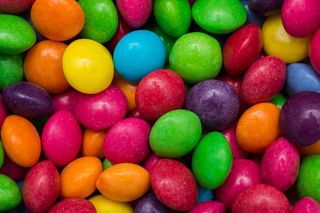Candy Chromatography | Holiday Science Project

Sugar plums and candy canes, M&Ms and chocolates. These may be a few of your favorite things around the holidays. Have you ever wondered how candy got its color?
This experiment in paper chromatography will show you which dyes were used to make the colors on your favorite candies.
What is chromatography?
Chromatography is a method of separating the different components of a mixture or solution. In paper chromatography, a mixture is dissolved and a drop is put on a piece of paper. The mixture separates and the components flow up the paper at different rates. The pattern that the separated substances make is a "chromatogram."
What you need
- 15 pieces of hard-shell, colored candies (such as M&Ms or Skittles): 5 each of 3 different colors you wish to test (for example, 5 brown M&Ms, 5 red M&Ms and 5 blue Skittles – or some other combination)
- Coffee filters: enough to make 30 test strips each 1 by 3 inches (2.5 by 8 centimeters)
- Scissors
- Pencil
- Ruler
- Pie plate or jar lid
- Transparent plastic cup or drinking glass
- Disposable pipette or clean eyedropper
- Wooden or plastic coffee stirrers (4)
- Measuring cup and measuring spoons
- Container large enough to hold 4 cups of water
- Wide-mouth glass jar
- Mini binder clips (2)
- Food coloring: red, green and blue
- Salt
- Water
What to do
Prepare test strips
- Cut coffee filters into identical strips of about 1 by 3 inches (2.5 by 8 centimeters).
- Use a pencil to lightly label each strip: 3 strips for each color of candy and 3 strips for each color of food coloring.
- Draw a light pencil line across the width of each strip about half an inch (or about 1.5 cm) from the bottom. This will be the starting line for your test drop of candy dye.
Extract dye from candies
- Put some water in a cup. Use the eyedropper to move a single drop of water to the pie plate. Carefully set a single candy in the drop of water. Let rest for at least 3 minutes while the dye dissolves out of the candy into the water.
- Remove and discard the candy.
- Touch the tip of a coffee stirrer to the colored drop and transfer a droplet of colored water to the middle of the starting line on the appropriate test strip. Allow the droplet to dry completely.
- Repeat step 3 three more times. You are layering a total of 4 drops of dye on your starting line.
- Prepare 4 more test strips with identical candies (for example a total of 5 test strips prepared from 5 brown M&Ms)
- Prepare 5 test strips for each type of candy you are testing
- In a similar manner, prepare 5 strips for each of the colors of food coloring. These will be your “known” dye colors. Later you will be comparing the strips prepared from the candy dyes to the dyes in these “known” colors.
Prepare the solvent
- Dissolve one-eighth teaspoon of salt in 4 cups of water (fill one-fourth teaspoon about half full) — this is close to a 0.1 percent salt solution.
- Stir until the salt is completely dissolved.
Do the chromatography
- Pour a small amount of the salt solution into the bottom of a transparent cup or drinking glass.
- Clip two chromatography strips to a coffee stirrer and balance the stirrer across the top of the cup or drinking glass. The strips should hang down into the glass.
- If needed, add more salt solution so the bottom edge of the test strip just touches the surface of the solvent (the salt water). Your starting line with the drop of color should be just above the surface of the salt water.
- Allow the solvent to creep up the strip by capillary action, carrying dye with it until it is half an inch from the top of the strip.
- Allow the test strips to dry. Use a pencil to mark how far the dye traveled up the strip.
- Compare the dyes extracted from the candy to the “known” food color dyes.
Questions
- What colors do you see on the chromatogram?
- Are any of the strips similar?
- Where are the differences?
- Can you tell which food dyes were used to color the candy?
Also try the experiment with colored markers, powdered drink mix or flavored gelatin.
More Holiday Science Experiments
More Science Fair Projects
- High School Science Fair Projects
- Middle School Science Fair Projects
- Weather Experiments / Science Fair Projects
- How to Choose a Science Fair Project Topic
- Cool Science Experiments for Hot Summer Days
Further resources:
Sign up for the Live Science daily newsletter now
Get the world’s most fascinating discoveries delivered straight to your inbox.
